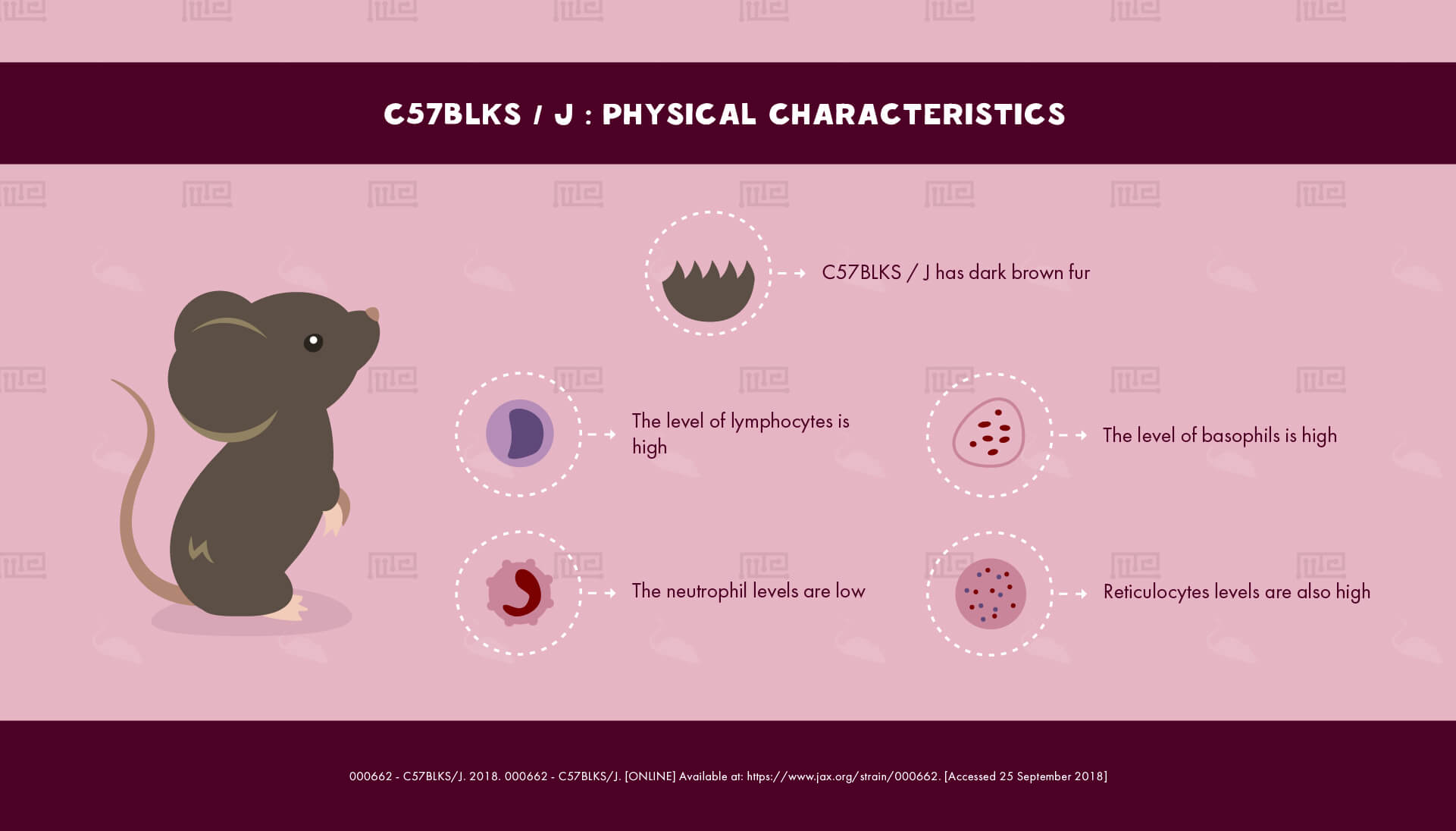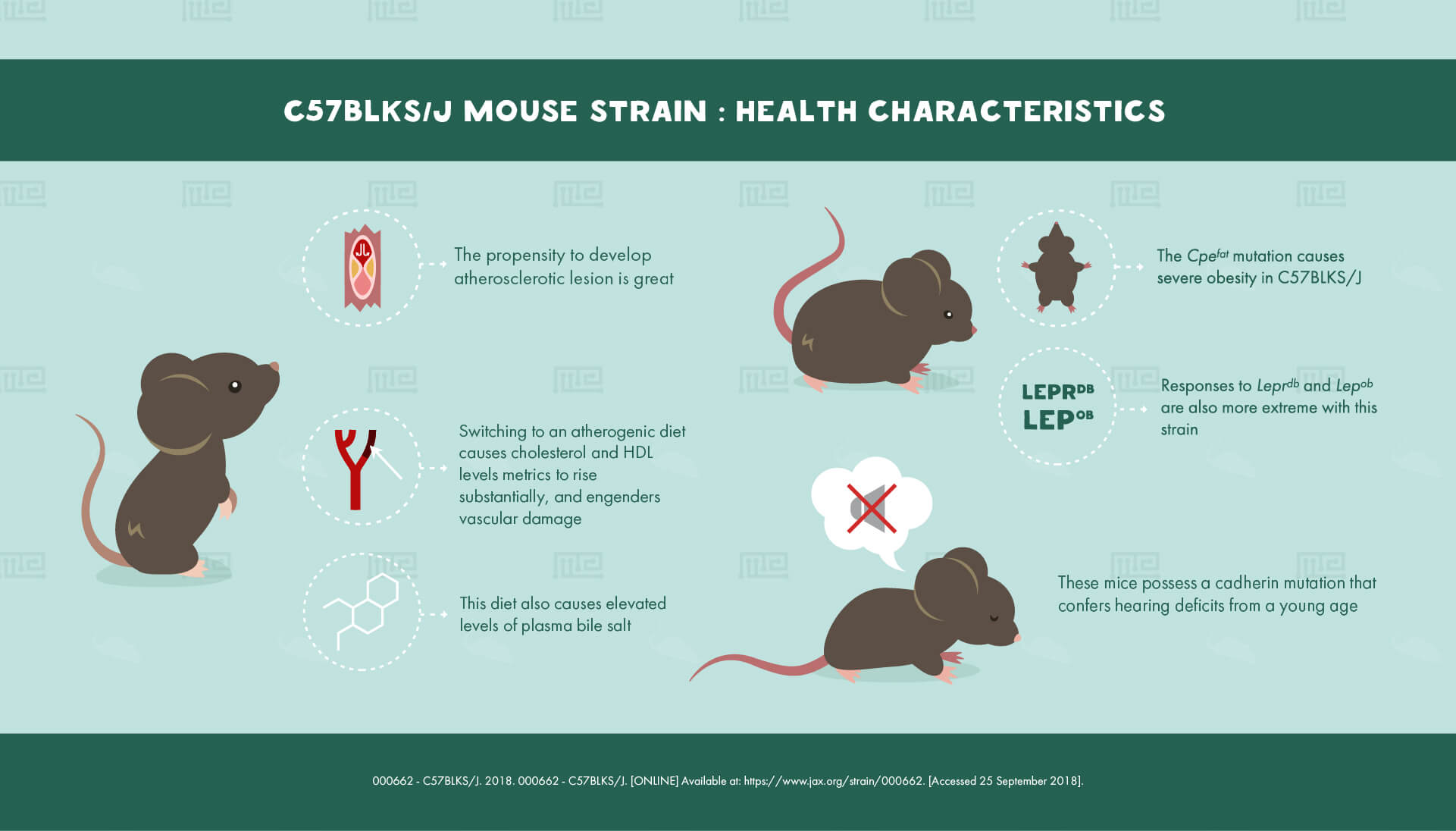Overview
C57BLKS/J, also known as Black Kaliss J and BKS, is a mouse strain that is related to the very commonly used C57BL/6J. It is primarily applied to metabolic research.[1]
History
Dr. N. Kaliss of the Sloan-Kettering Institute acquired a pair of C57BL/6J mice from separate sources in 1947, in order to breed his own stock of this strain. He inbred these mice for a year before bringing them to the Jackson Laboratory.
The first sign that genetic drift had occurred in this stock came when these mice rejected a sarcoma that had been taken from one of Jackson Laboratory’s C57BL/6J mice. It became clear that some kind of genetic change had occurred in Kaliss’s stock that made them incompatible with their parent strain.
A detailed genomic analysis found that Kaliss’s mice shared 25% of their DNA with the DBA/2J strain. At some point, Kaliss must have accidentally created a C57BL/6J-DBA/2J hybrid by contaminating his stock with the wrong mice. Given its interesting phenotypic differences from their parent strain, the C57BLKS/J strain was maintained as a new lineage and has been kept at the Jackson Laboratory ever since.[1]
Physical Characteristics
C57BLKS/J has dark brown fur. In outward appearance, it is not noticeably different from C57BL/6J. Levels of immune cells in the strain’s bloodstream are unusual, with neutrophil levels low, and levels of lymphocytes and basophils high. Reticulocyte levels are also high.[1]
Behavioral Characteristics & Handling
The Jackson Laboratory describes C57BLKS/J mice as “quiet” and “easy to handle”. They caution that barbering is common. Nonetheless, it seems very likely based on this description that experimenters can expect high ease of handling when using this strain.[2]
They breed poorly with small litter sizes but nonetheless display good parenting.[2] They display generally average performance compared to other strains in the open field test, in respect of both distance traveled and time spent away from the center, suggesting normal levels of anxiety and exploratory motivation.[3]
Health Characteristics
The most notable difference between C57BLKS/J and C57BL/6J is the former strain’s much greater propensity to develop atherosclerotic lesions. This propensity is also greater than that of many other frequently used strains.
Whilst both total cholesterol and HDL levels remain low in C57BLKS/J when the mice are fed a normal diet, switching to an atherogenic diet causes both of these metrics to rise substantially, and engenders vascular damage, as well as causing elevated levels of plasma bile salts.
The C57BLKS/J strain responds much more strongly than other strains to several mutations. Whereas the Cpefat mutation only causes mild obesity in the HRS/J strain (alongside hyperglycemia and hyperinsulemia common to both strains), it causes severe obesity in C57BLKS/J. Responses to Leprdb and Lepob are also more extreme with this strain.
These mice possess a cadherin mutation, commonly found in inbred mouse strains, that confers hearing deficits from a young age.[1]
Major Experimental Uses
C57BLKS/J mice are mainly used in metabolic research on obesity and diabetes mellitus type 2, providing an interesting contrast to their parent strain. They are also applied to the study of hearing defects.[1]
References
- 000662 – C57BLKS/J. 2018. 000662 – C57BLKS/J. [ONLINE] Available at: https://www.jax.org/strain/000662. [Accessed 25 September 2018].
- The Jackson Laboratory Handbook on Genetically Standardized Mice. 2009. [ONLINE]. Available at: http://jackson.jax.org/rs/444-BUH-304/images/JAX%20Handbook%20Genetically%20Standardized%20Mice.pdf
- Miller BH, Schultz LE, Gulati A, Su AI, Pletcher MT (2010) Phenotypic Characterization of a Genetically Diverse Panel of Mice for Behavioral Despair and Anxiety. PLoS ONE 5(12): e14458.


